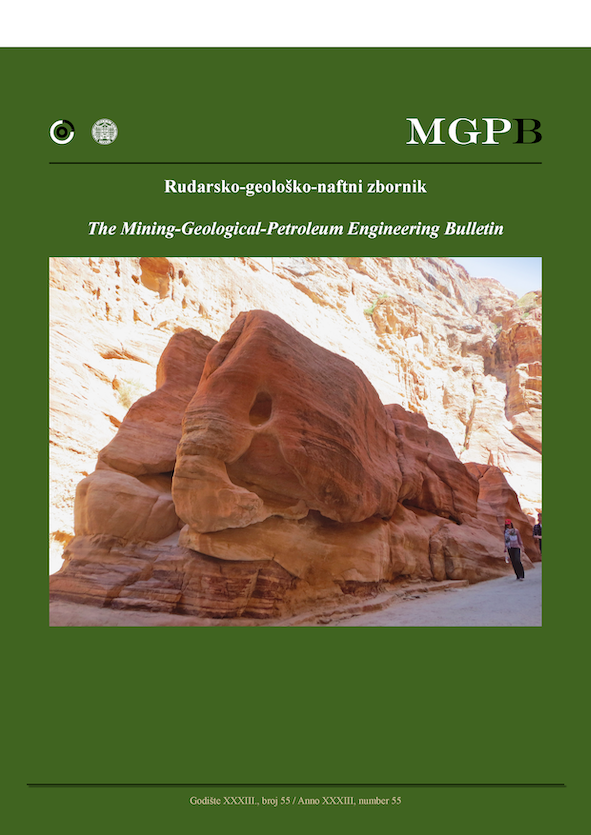Submarine tectonic geomorphology of the Pliny and Hellenic Trenches reflecting geologic evolution of the southern Greece
DOI:
https://doi.org/10.17794/rgn.2021.4.4Keywords:
geophysics, Generic Mapping Tools, Hellenic Trench, cartography, geologyAbstract
Mapping seafloor geomorphology is a complex task requiring integration of the advanced cartographic technologies and high-resolution spatial data. This paper provides a comparative geomorphological analysis of the Hellenic Trench (HT) and Pliny Trench (PT) located in Eastern Mediterranean Sea, southern Greece. These trenches are formed as a results of the tectonic plate subduction in the Eastern Mediterranean Sea: northward motion of the African and Arabian plates, complicated by the regional geological settings such as active faults, earthquakes, which resulted in their different geomorphological forms and bathymetric shapes. Technically, the paper presents example of the advanced scripting mapping by scripting cartographic toolset Generic Mapping Tools (GMT), which performs mapping through shell scripts. The maps are based on the high-quality topographic, geological and geophysical data: GEBCO, EGM96, geoid, marine free-air gravity fields. The GMT builds upon the modules used for data processing. The region was subsetted by 'grdcut', analysed by the Geospatial Data Abstraction Library (GDAL) (gdalinfo utility), visualized by 'grdimage'. Two segments of the trenches formed in a condition of varying geological and geophysical settings, have been modelled, visualized and compared, as representative cross-sections. As a result of the automated digitizing, spatial interpolation and sequential aggregating of GMT codes, the segments of the cross-sections were represented. The HT (Ionian segment) has an asymmetric one-sided shape; steepness 56.8° on the NE side and 7° on the SW flank. The PT has a more symmetric view; steepness 42,14° on its NW flank and 26,66° on its SE flank. The PT has a clear peak of the depths at -2600 to -2800 m and the most representative data range at -5000 to -6000 m. The HT has a bimodal data distribution with two peaks. The most frequent data for HT: -3200 m to -3400 m. Comparing to PT, the HT is deeper. The histogram shows the peak of data for HT in the interval between the -3200 to -3400 m (135 samples) while the PT shows the peak of data in the interval at -2600 to -2800 m (310 samples). Besides, 105 samples of the HT have depths exceeding 4000 m, while only 20 sample are recorded for PT in the same interval. The paper contributes to the geomorphological studies of the Eastern Mediterranean Sea region in general and regional seafloor mapping of the Hellenic and Pliny trenches in particular.Downloads
Published
How to Cite
Issue
Section
License
Copyright (c) 2021 authors and journal

This work is licensed under a Creative Commons Attribution 4.0 International License.
Creative Commons-BY
Authors who publish with this journal agree to the following terms:
In agreeing this form, you certify that:
- You read the ethical codex of the RGN zbornik available at journal web.
- You submitted work is your original work, and has not previously been published and does not include any form of plagiarism.
- You own copyright in the submitted work, and are therefore permitted to assign the licence to publish to RGN zbornik.
- Your submitted work contains no violation of any existing copyright or other third party right or any material of an obscene, libellous or otherwise unlawful nature.
- You have obtained permission for and acknowledged the source of any illustrations, diagrams or other material included in the work of which you are not the copyright owner.
- You have taken due care to ensure the accuracy of the work, and that, to the best of your knowledge, there are no false statements made within it.
- All co-authors of this submitted work are aware of, and in agreement with, the terms of this licence and that the submitted manuscript has been approved by these authors.
Publication licence
You retain copyright in your submitted work, according to journal license policy (CC-BY). By signing this form you agree that RGN zbornik may publish it under the publication licence. In summary the licence allows the following:
Anyone is free:
- To copy, distribute, display, and perform the work.
- To make derivative works.
Under the following conditions:
- The original author must always be given credit.
- The work may not be used for commercial purposes.
- If the work is altered, transformed, or built upon, the resulting work may only be distributed under a licence identical to this one.
Exceptions to the licence
In addition to publishing the work printed under the above licence, RGN zbornik will also enable the work to be visible online.
The journal editorial can change the licence rules anytime but it cannot retroactively restrict author(s) rights.


